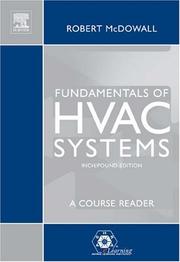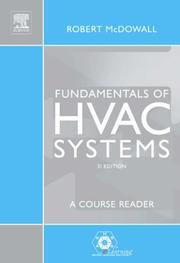| Listing 1 - 9 of 9 |
Sort by
|

ISBN: 1281052280 9786611052287 0080477941 012372497X 9780123724977 Year: 2006 Publisher: Oxford : Butterworth-Heinmann,
Abstract | Keywords | Export | Availability | Bookmark
 Loading...
Loading...Choose an application
- Reference Manager
- EndNote
- RefWorks (Direct export to RefWorks)
Heating, Ventilation and Air-Conditioning(HVAC) systems are omnipresent in modern buildings. This book is an introduction for those involved in the specification, design, manufacture, installation, operation or maintenance of these systems.
Heating. --- Ventilation. --- Air conditioning. --- Airconditioning --- Buildings --- Conditioning, Air --- Air --- Dampness in buildings --- Refrigeration and refrigerating machinery --- Ventilation --- Ventilating --- Air conditioning --- Heat engineering --- Boilers --- Stoves --- Environmental engineering --- Purification --- Heating and ventilation --- Aerodynamics

ISBN: 9780123739988 0123739985 9780080467795 0080467792 9786610746996 1280746998 0080914926 Year: 2007 Publisher: Atlanta, GA : Amsterdam ; Boston : American Society of Heating, Refrigerating and Air-Conditioning Engineers eLearning ; Elsevier,
Abstract | Keywords | Export | Availability | Bookmark
 Loading...
Loading...Choose an application
- Reference Manager
- EndNote
- RefWorks (Direct export to RefWorks)
Everything that new HVAC&R engineers will be expected to learn, from the leading industry body - ASHRAE
Heating. --- Ventilation. --- Air conditioning. --- Airconditioning --- Buildings --- Conditioning, Air --- Air --- Dampness in buildings --- Refrigeration and refrigerating machinery --- Ventilation --- Ventilating --- Air conditioning --- Heat engineering --- Boilers --- Stoves --- Environmental engineering --- Purification --- Heating and ventilation --- Aerodynamics

ISBN: 9780123724977 012372497X Year: 2006 Publisher: Amsterdam Elsevier
Abstract | Keywords | Export | Availability | Bookmark
 Loading...
Loading...Choose an application
- Reference Manager
- EndNote
- RefWorks (Direct export to RefWorks)
Heating, Ventilation and Air-Conditioning (HVAC)systems are omnipresent in modern buildings. This book is an introduction for all those involved in the specification, design, manufacture, installation, operation or maintainance of these systems. Developed jointly with the ASHRAE Learning Institute, the leading and recognised technical experts in the industry. This Inch-Pound edition is primarily for use in US markets. An SI version is also available on ISBN 0123739985. The book explains: The objectives to be achieved by a system in terms of environmental control. The description of a system - including primary equipment, means of distribution, space and load determination, and operating strategy. The basic function of components that form HVAC systems. The layout and functioning of common HVAC systems, including all-air systems, air-water systems, and all-water systems. The strategies for operating systems and their basic means of control. Identifying the most suitable type of system for different types of application * Air-conditioning is a major industry and growing. Shows how systems operate and how to select, design and operate them efficiently to minimise installation cost and ongoing energy cost * Endorsed by, and developed with ASHRAE, the leading trade body and recognised technical experts * Provides a thorough introduction to how HVAC systems function in controlling temperature, air quality, and air circulation in a controlled space.

ISBN: 9780123739988 0123739985 9780080467795 0080467792 0080914926 1280746998 9786610746996 Year: 2007 Publisher: Atlanta, GA : Amsterdam ; Boston : American Society of Heating, Refrigerating and Air-Conditioning Engineers eLearning ; Elsevier,
Abstract | Keywords | Export | Availability | Bookmark
 Loading...
Loading...Choose an application
- Reference Manager
- EndNote
- RefWorks (Direct export to RefWorks)
Everything that new HVAC&R engineers will be expected to learn, from the leading industry body - ASHRAE
Heating. --- Ventilation. --- Air conditioning.
Book
Year: 1944 Publisher: London : Murray,
Abstract | Keywords | Export | Availability | Bookmark
 Loading...
Loading...Choose an application
- Reference Manager
- EndNote
- RefWorks (Direct export to RefWorks)
Book
ISBN: 0709955030 Year: 1988 Publisher: London Croom Helm
Abstract | Keywords | Export | Availability | Bookmark
 Loading...
Loading...Choose an application
- Reference Manager
- EndNote
- RefWorks (Direct export to RefWorks)
Animal ethology and ecology. Sociobiology --- Zoogeography --- Fishes
Book
Year: 1930 Publisher: London : Murray,
Abstract | Keywords | Export | Availability | Bookmark
 Loading...
Loading...Choose an application
- Reference Manager
- EndNote
- RefWorks (Direct export to RefWorks)
Digital
ISBN: 9780080915135 0080915132 0080552331 9780080552330 Year: 2009 Publisher: Atlanta, GA American Society of Heating, Refrigerating and Air-Conditioning Engineers
Abstract | Keywords | Export | Availability | Bookmark
 Loading...
Loading...Choose an application
- Reference Manager
- EndNote
- RefWorks (Direct export to RefWorks)
Heating, Ventilation and Air-Conditioning (HVAC)control systems are omnipresent in modern buildings. This book is an introduction to all those involved in the specification, design, manufacture, installation, operation or maintainance of these systems. The book explains: Control theory and how to evaluate, select, position and sequence the appropriate type of control. The electrical knowledge needed to understand controls and the use of electrical circuit drawings. The various types of valves and dampers, and their selection, installation and operation. Terminology and attributes of sensors, the selection of moisture sensors, pressure, flow, and auxiliary devices. Self-powered and system-powered controls. Electric controls, control diagrams and control logic. The components of pneumatic systems and control applications diagrams. Wiring conventions, application-specific electronic controllers and how to use them in HVAC applications. The use of written specifications, schedules, and drawings to clearly identify what is to be installed, how it is to be installed, and how it is expected to operate. Direct Digital Controls (DDC) components, their inputs and outputs, and the programming of DDC routines. DDC Networks and Protocols .DDC Specification, Installation and Commissioning After completing this course, you will understand: Control theory and how to evaluate, select, position and sequence the appropriate type of control. The electrical knowledge needed to understand controls and the use of electrical circuit drawings. The various types of valves and dampers, and their selection, installation and operation. Terminology and attributes of sensors, the selection of moisture sensors, pressure, flow, and auxiliary devices. Self-powered and system-powered controls. Electric controls, control diagrams and control logic. The components of pneumatic systems and control applications diagrams. Wiring conventions, application-specific electronic controllers and how to use them in HVAC applications. The use of written specifications, schedules, and drawings to clearly identify what is to be installed, how it is to be installed, and how it is expected to operate. Direct Digital Controls (DDC) components, their inputs and outputs, and the programming of DDC routines. DDC Networks and Protocols. DDC Specification, Installation and Commissioning.
Book
ISBN: 9780080915135 0080915132 0080552331 9780080552330 9786612167423 1282167421 0080569927 Year: 2008 Publisher: Burlington, MA ; Oxford : Elsevier Science,
Abstract | Keywords | Export | Availability | Bookmark
 Loading...
Loading...Choose an application
- Reference Manager
- EndNote
- RefWorks (Direct export to RefWorks)
Heating, ventailation and air-conditioning control systems are omnipresent in modern buildings. This book introduces the things involved in the specification, design, manufacture, installation, operation or maintenance of these systems.
Heating --- Ventilation. --- Air conditioning --- Control. --- Temperature control --- Buildings --- Ventilating --- Dampness in buildings --- Thermostat --- Heating and ventilation --- Ventilation --- Aerodynamics --- Environmental engineering --- Regulators --- Equipment and supplies
| Listing 1 - 9 of 9 |
Sort by
|

 Search
Search Feedback
Feedback About UniCat
About UniCat  Help
Help News
News